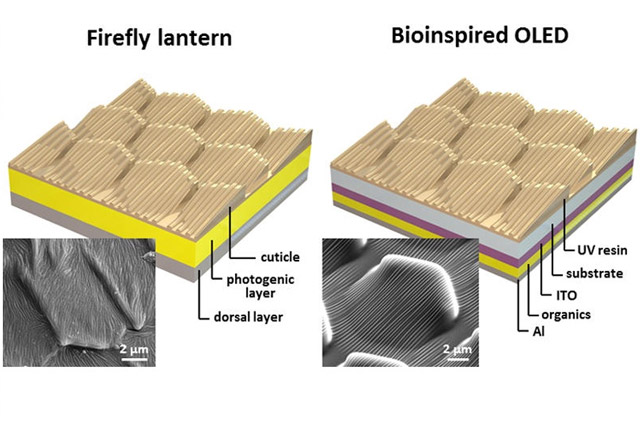
Fireflies use what scientists discovered is a pattern of hierarchical structures, per a research paper on Phys.org. These chitinous micro-structures make up the surface of the light emitting portion of the firefly (its butt!) and are much different from the smooth surfaces that most human-made lights use.
Analyzing these micro-structures, scientists were able to replicate them in a new form of organic light-emitting diode (OLED) that is as much as 60 percent more efficient than traditional LEDs and even delivers a 15-percent wider angle of illumination.
These layered cuticles enhance the proliferation of the light, preventing it from being trapped within the firefly’s lantern structure, thereby making it a more efficient light emitter. The same can now be said for man-made OLEDs, thanks to this inspiration.
How to prevent internal reflection within LEDs is something researchers have grappled with for some time, as it makes a sizable impact on the amount of light that can be emitted. Increasing the amount of light put out by the LED has diminishing returns, as more and more is reflected inwards.
Using this new design, scientists have eliminated much of that problem.
Although some measure of knowledge about the humble firefly’s light-emitting abilities were known before, it’s only now that scientists have taken that inspiration and built something with it.
“Our breakthrough technology is the large-scale fabrication of inclined microstructures and highly ordered nanostructures on each inclined microstructure,” said Ki-Hun Jeong, lead researchers at the Korea Advanced Institute of Science and Technology. “We strongly believe that these biologically inspired OLEDs open a new paradigm for engineering biomimetics for lighting applications.”
The research firm is now hoping to strike a deal with a commercial manufacturer to turn the unique design into a viable product, providing more powerful and efficient LED lighting to all who want it.
If all goes well, perhaps we’ll see better laptop battery life, brighter screens, and greener products in the future — all thanks to the humble firefly’s butt.



